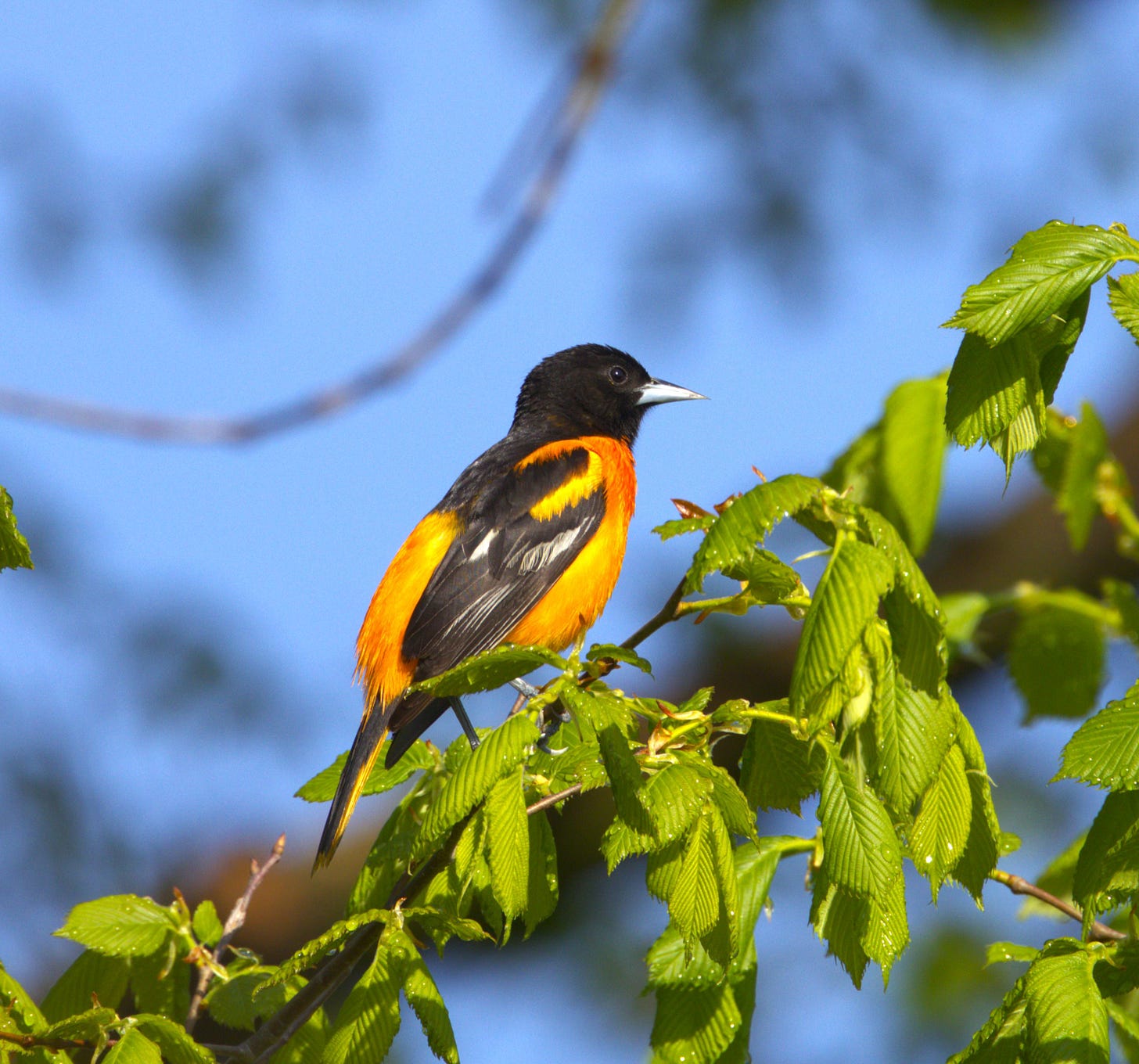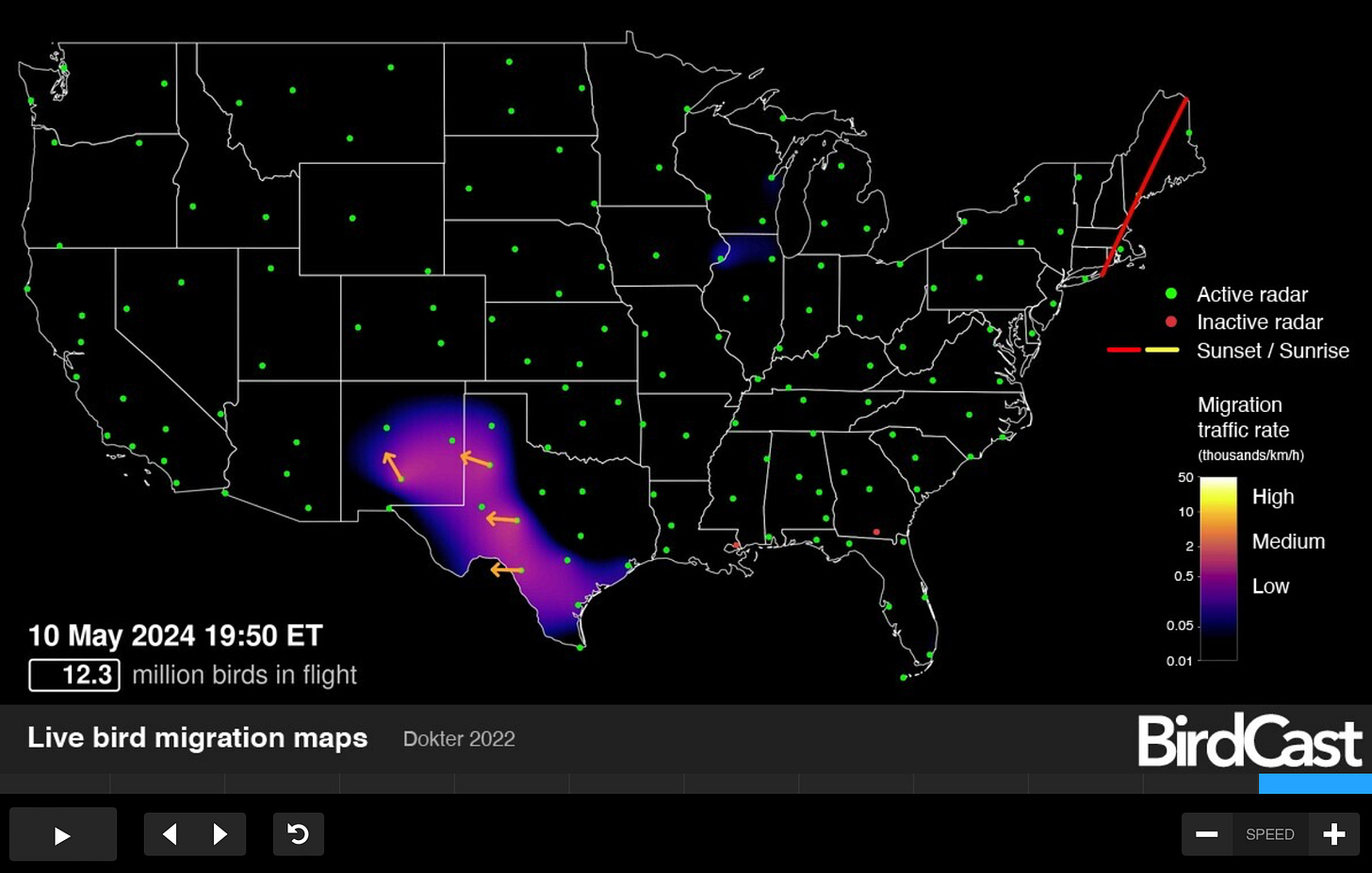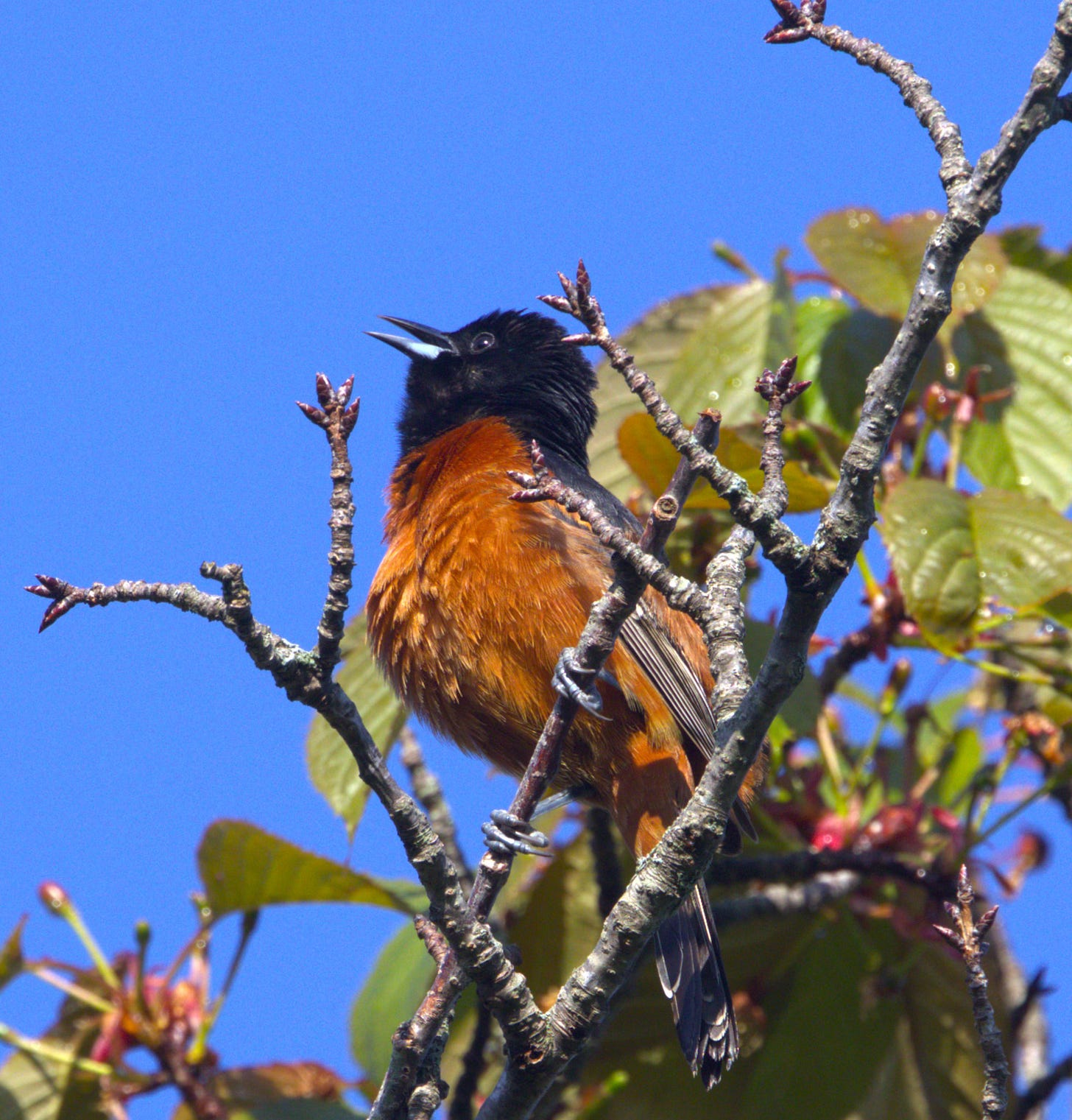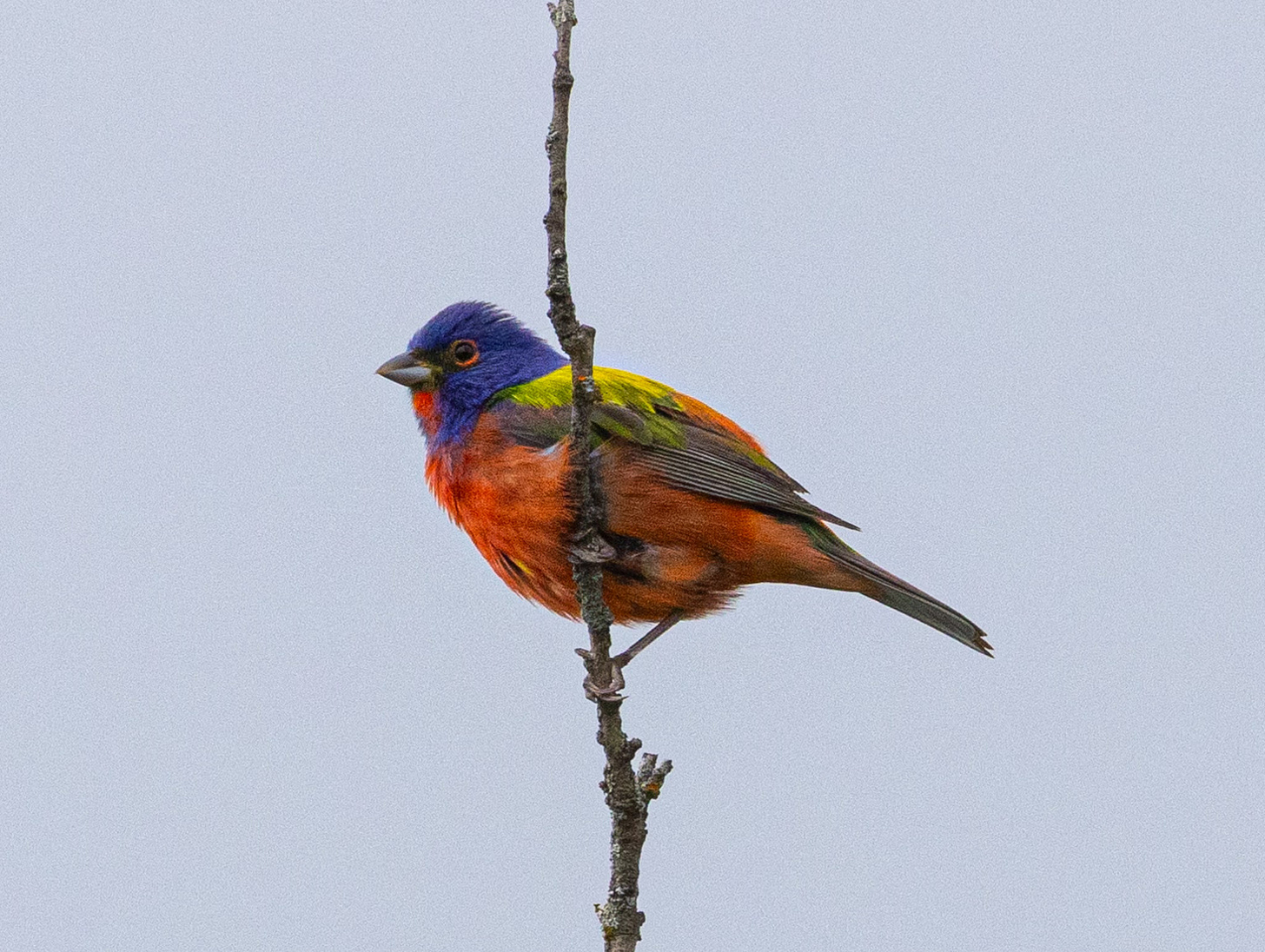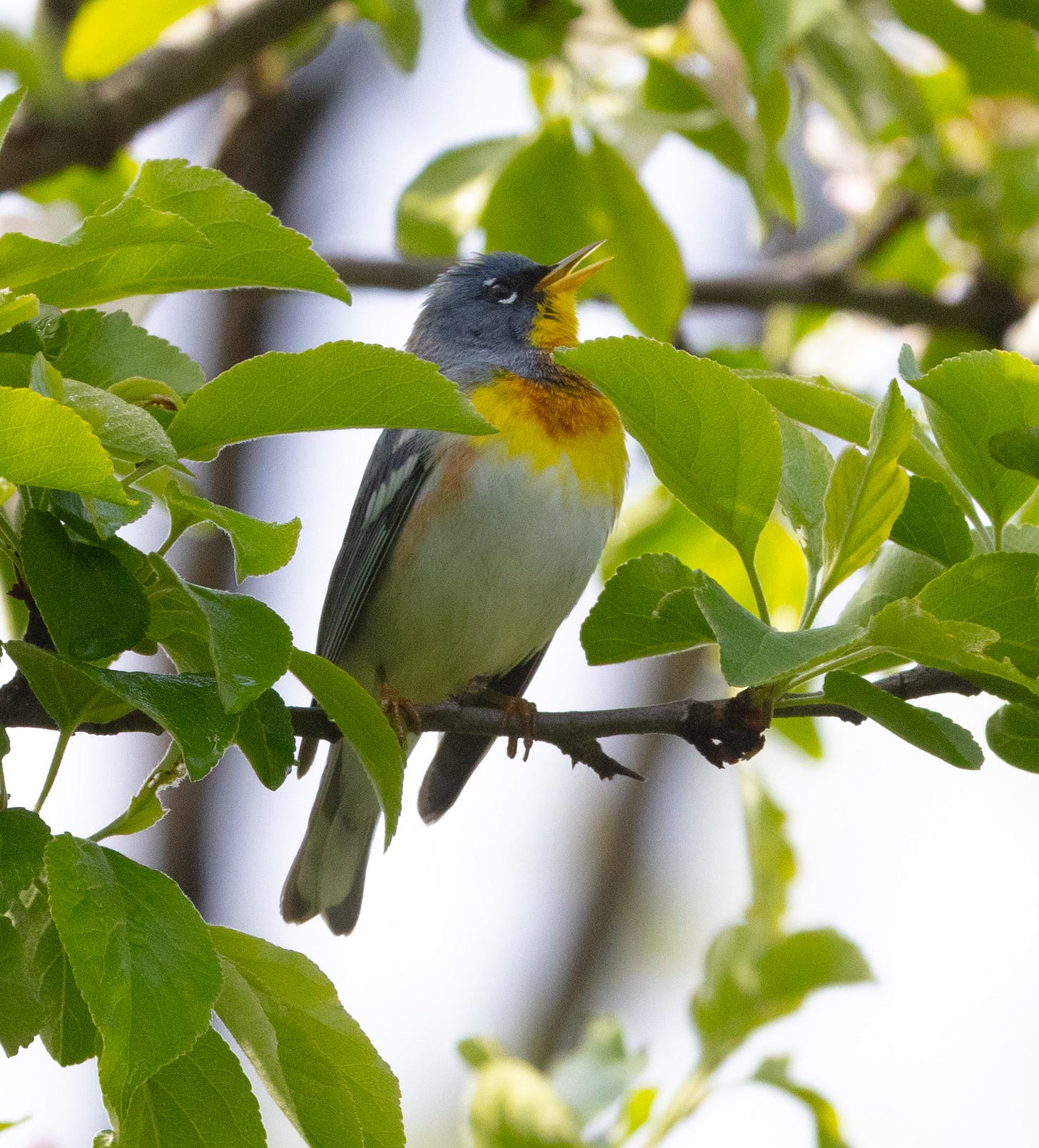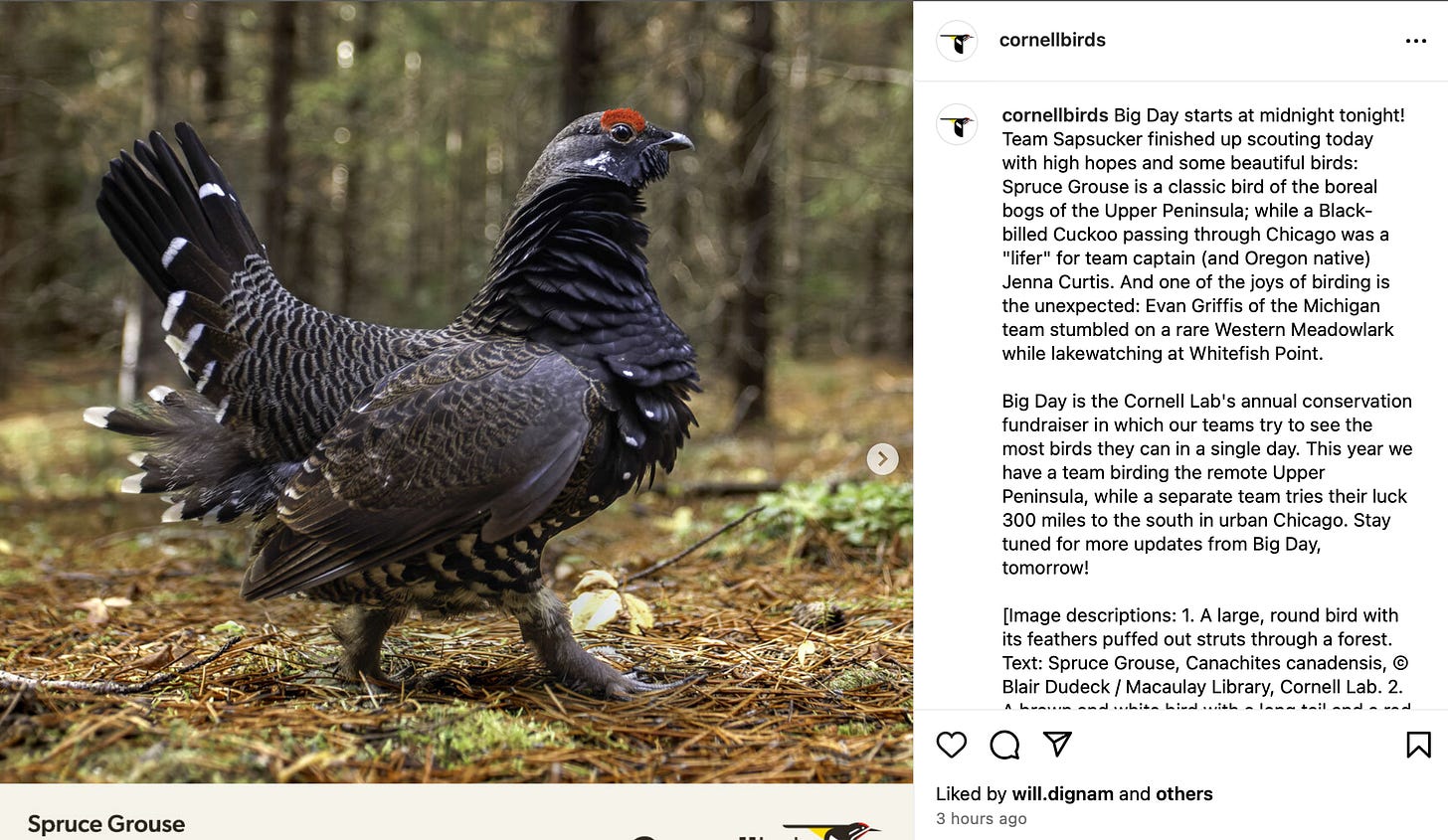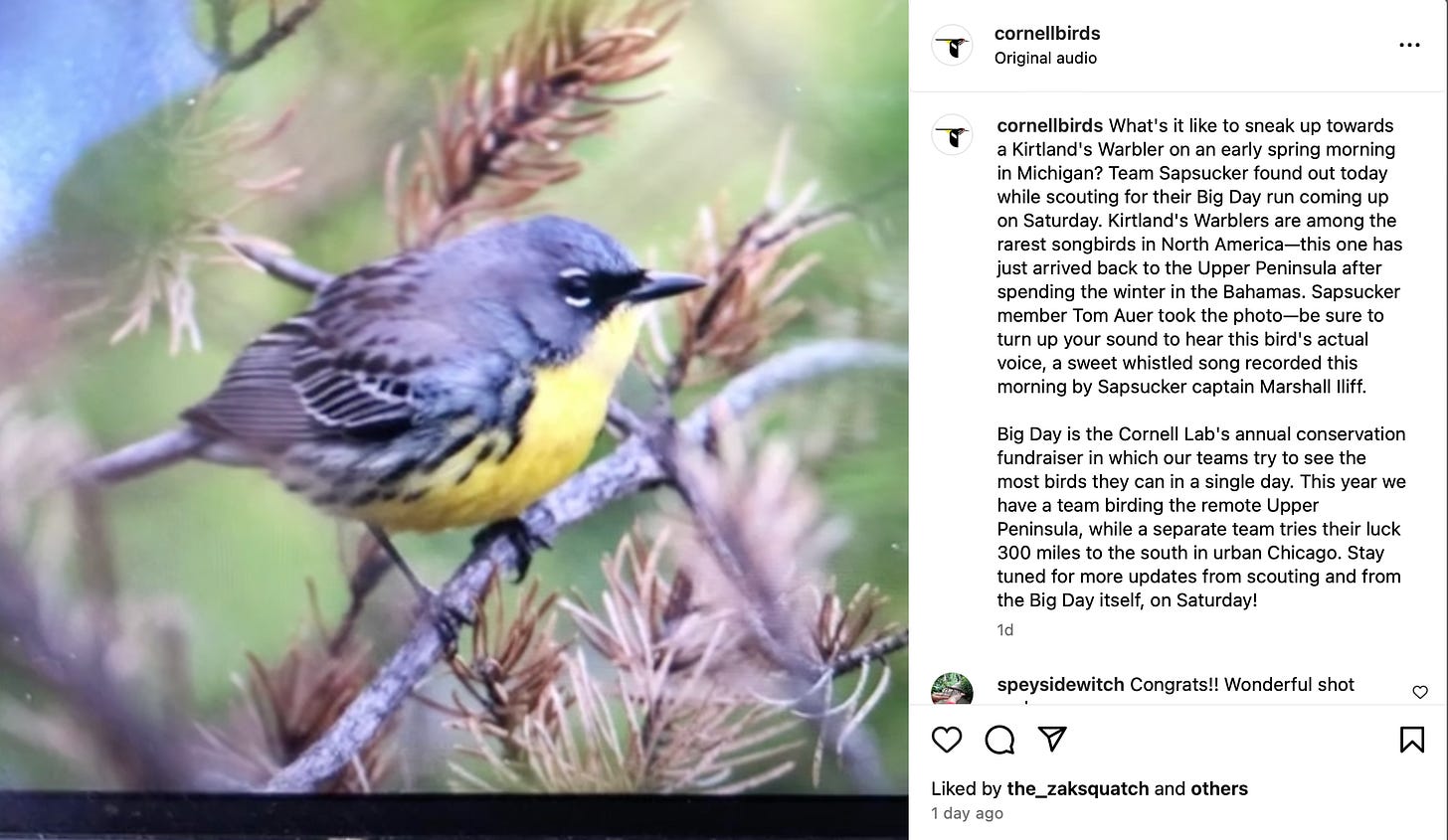Migration in Full Swing.
Bird News Items
1. Let’s start with a fun piece on what is truly one of the great “hotspots” to witness the magic and majesty of Spring Migration: Oak Harbor, Ohio — “Over there!” A tall young man points above the crowd. “Where the two logs are. One arches up and toward the left. A magnolia is moving in the branches.” Named after the tree in which they were discovered, male magnolia warblers are striking birds, with a coal-black mask and a brilliant yellow belly covered with a dark “necklace.” Bodies and binoculars twist for a glimpse. Camera shutters clatter furiously, and then only birdsong fills the air again. I’m at the boardwalk of Magee Marsh Wildlife Area in Oak Harbor, Ohio, for the annual 10-day Biggest Week in American Birding Festival, created in 2010 by the conservation organization, Black Swamp Bird Observatory. Migrating songbirds, especially warblers, stop here every May, one of the major flyways for bird migration. (via National Geographic)
More on “Biggest Week in American Birding” here in a report from a local ABC affiliate.
2. Podcast featuring Noah Matson (U.S. Fish and Wildlife) and Amanda Rodewald (Cornell Lab of Ornithology) celebrating World Migratory Bird Day - worth a listen: Billions of birds are making their way around the world right now as part of their annual spring migration. But climate change, habitat loss, and human infrastructure are making that journey harder for a lot of species. That’s why conservation and government groups come together twice a year to celebrate World Migratory Bird Day – but maybe they also just want an excuse to talk about our feathered friends. Either way, we’re happy to oblige. (via WAMU, National Public Radio)
By Hap Ellis, Baltimore Oriole - Arnold Arboretum, Boston, MA.
3. NPR’s All Things Considered went to the mountains in Los Angeles to check out migration: It is really early in the morning here, like, way too early for me. The sun is just starting to peek over the San Gabriel Mountains just north of Los Angeles. Is it pre- or during or post-sunrise? What is this (laughter)? You may ask, why am I here at the crack of dawn, standing in the middle of a dirt parking lot in the mountains? Well, I had a date with a Ph.D. student named Kelsey Reckling. Reckling is studying bird migration at UCLA. And for the last month and a half, she has been showing up at this parking lot in the wee hours of the morning to count birds. (via Baton Rouge Public Radio)
4. 24.5 million birds, one night in Illinois (May 5th), and …Chicago: As hundreds of millions of birds migrate northward for their spring breeding season, the city of Chicago has a critical role to play in keeping the animals safe. Benjamin Van Doren, an assistant professor of environmental sciences at the University of Illinois at Urbana-Champaign, says that Chicago’s location in the Midwest and along the Great Lakes puts it right at the epicenter of the flight path of millions of birds. Those bird species are continuing to pass through in breathtaking numbers in recent days, with 24.5 million birds flying in Illinois at approximately 11 p.m. Sunday night. More than seven million birds crossed out of the state as they make their way northward to breeding grounds in Wisconsin and Canada, with everything from Yellow Warblers to Baltimore Orioles passing through. (via NBC Chicago)
5. Check this out - Go to Live bird migration maps - BirdCast - and select the date 2024/04/28. Watch how, as sun sets across the country, 370 million birds can be tracked migrating north. Migration!!
6. And then check out this migration report from Arran (Scotland): While there was a third less rain than March - the wettest month of the year - and the mean temperature was one degree warmer than March, it still felt like a wet, cold month. There was respite from the rain from April 19 to April 28, but it was cold. The impact on migrating birds of the weather here and throughout their route is difficult to know, but even by the end of the month the bulk of the migrants had still to arrive. A number of observers felt there were fewer birds around than recent years. The impact of inclement weather on breeding birds remains to be seen but some initial nests of shore breeding birds were washed away and some grey heron chicks were blown out of their nests in Lochranza on April 9. In April there were more than 110 species recorded on Arran. (via Oban Times)
7. Two Broods (XIII and XIX), trillions with a “T”, rewiring a food web?: This April, trillions of periodical cicadas began their descent on the midwest and southeast of the United States, causing so much noise that local residents called the police to complain. But the cicadas don't just disrupt neighbourhoods with a deafening soundtrack, they also throw food chains into chaos. After spending more than a decade burrowed underground sipping on tree root juices, two broods – Brood XIII and Brood XIX – are emerging at the same time in 2024: the first time they have done so simultaneously since 1803. For predators, these emergences are a huge boom in resources. It's basically like an all-you-can-eat buffet for the hungry predator. (via BBC)
By Hap Ellis, Orchard Oriole - Arnold Arboretum, Boston, MA.
8. Avian flu update - are we really blaming migrating birds? Migratory birds are getting a bad rap right now, as avian influenza cases multiply and appear in new species. “The reason it’s become such a threat is because of how widespread it’s become in wild birds,” journalist Emily Anthes said of H5N1 on The Daily recently. “Wild water birds, in particular, are known for carrying these viruses.” It’s true that migratory birds brought H5N1 to North and South America in late 2021, and they can continue spreading it around the globe. But this variant didn’t start with them. Bird flu was first identified among chickens on a farm in Scotland in 1959. In 1996, it began drawing more attention when it was found on a goose farm in Guangdong, China, and then spread to people, killing more than half of those with confirmed infections. (via The New Republic)
9. Kun-Wac-Shun - a “lynch pin” in the California Condor’s success: Usher and Lil Jon were bouncing out of car stereo systems, “13 Going On 30″ was a must-watch romcom, and if you asked someone, “Have you seen ‘The Office’?” you would have been talking about the British version. It was May 9, 2004, and, at the Oregon Zoo’s condor conservation center in Clackamas County, a condor emerged from his egg. Kun-Wac-Shun, also known as No. 340, was the first of a long line of condors hatched at the Jonsson Center for Wildlife Conservation. His name means “Thunder and lightning” and the name was given to him by Chief Nelson Wallulutum of the Wasco tribe. Since the program began in 2003, almost 120 chicks have hatched at the conservation center and released at different sites in California and Arizona. Kun-Wac-Shun was released at Pinnacles National Park in 2005 and since then, he’s become a lynchpin in the success of the species in the wild. (via Seattle Times)
10. Can the raptor declines in Africa be reversed? These sanctuaries are trying: Simon Thomsett tentatively removes a pink bandage from the wing of an injured bateleur, a short-tailed eagle from the African savannah, where birds of prey are increasingly at risk of extinction. The 18-month-old eagle, with a distinctive red beak and black body, was brought to the shelter five months ago, where about 30 other injured raptors keep it company. The sanctuary in the Soysambu reserve is one of the few places where the birds of prey are safe. A study published in January by The Peregrine Fund, a United States-based non-profit organisation, found that the raptor population has fallen by 90 percent on the continent over the last 40 years. (via Al Jazeera)
11. Ever wonder what happens to birds in fierce hail storms?: When a great horned owl takes up residence in your backyard, it’s hard not to get attached. At least, that’s been the experience of Genna Dacanay. The Colorado Springs school counselor has spent the past year enjoying her resident owl, watching him in a nearby tree and logging his hoots in the Merlin app. So when a storm started pounding her home with some pretty extreme hail last summer, Dacanay was disturbed to spot “her” owl sitting on a tree stump out there in the midst of it. (via CPR)
By Hap Ellis, Painted Bunting - Ellis County, TX.
12. Concerning story on “forever chemicals” in some of Maine’s best known fish-eating birds: Equipped with a floating mesh net and black-and-white decoys, wildlife biologist Micah Miller jumped on a boat Monday to begin hunting for harmful forever chemicals in the bloodstreams of common eiders, North America’s largest native duck. Over the last three years, Miller has found high levels of the chemicals in blood drawn from eagles, loons and ospreys, some of Maine’s best known fish-eating birds. Now Miller is expanding his research to include the island-nesting species that prefers to feed on mussels. (via Portland Press Herald)
13. This bird has lost 99% of its population over the last century: As the ocean swells around the rocky shore of South Africa's Betty's Bay, penguins hop along the waterline, calling to one another in short raspy barks. They are endearingly comical as they totter about but Alistair McInnes looks worried. The African penguin – which is native to South Africa and Namibia - has lost 99% of its population over the last century. “If the current rates of decline persist into the near future we could see the extinction of the species within our lifetime by 2035, so the situation is extremely urgent,” Dr McInnes warns. This is why BirdLife South Africa and the Southern African Foundation for the Conservation of Coastal Birds (Sanccob) are taking legal action against the government in the first case of its kind in South Africa. (via BBC)
14. Sometimes all you need is a feeder: Country Diary: Scuppered by a bad back, I’ve been restricted to the couch, but I’m lucky – the bird feeder is right outside the window and it’s providing a living theatre of drama. Goldfinches and greenfinches fly down from the granny pines, an occasional great spotted woodpecker, a redpoll or two too, but it’s the siskins and chaffinches that dominate. There’s a flock of around 50 chaffinches and they’re practically all male. Their Latin name, Fringilla coelebs, speaks to this (coelebs meaning unmarried or single) and they’re sometimes known as batchelor birds. It’s a species that has a year-round surplus of males. They’re so ubiquitous that I rarely pay them any attention, but I’m noticing their colour palette anew – the black line above the bill, their steely blue nape and crown, their rusty pink breasts and how their gorgeous olive green rumps blend into the brown of their backs. (via The Guardian)
By Hap Ellis, Northern Parula - Arnold Arboretum, Boston, MA.
15. Finally, today is Global Big Day - Go birding!:Usually, there are two Global Big Days per year, one in May, and another in October. To double the birding fun, both Global Big Days typically coincide with World Migratory Bird Day. Global Big Day is a global event because birders really do participate from all around the world. On May 13, 2023, people from 198 countries submitted bird lists! The “Big Day” part comes from a birding challenge with the same name. In birding terms, a “Big Day” is when you identify as many birds as you can in one calendar day. This can take the form of a simple, easy-going day of birding, or, a much more extreme, 24 hour challenge. Most Global Big Day birders go the relaxed birding route but some few determined birders do start at midnight and end well after night falls! (via Birdzilla)
Bird Videos of the Week
Video by GeoBeats Animals, “Couple rescues wild sparrow: Now she refuses to leave”.
Cornell Live Bird Cam - Big Day Alert!
Cornell Live Bird Cam - Kirtland's Warbler.

